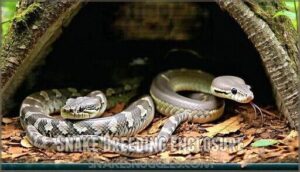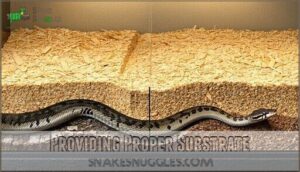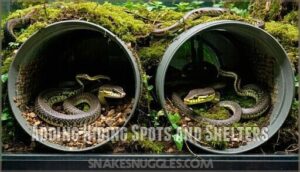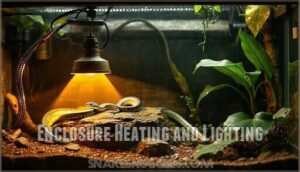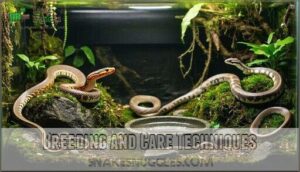This site is supported by our readers. We may earn a commission, at no cost to you, if you purchase through links.
 To create the best snake breeding enclosure setup, focus on mimicking your snakes’ natural environment while maintaining strict temperature, humidity, and safety controls.
To create the best snake breeding enclosure setup, focus on mimicking your snakes’ natural environment while maintaining strict temperature, humidity, and safety controls.
Start with a spacious vivarium—think of it as their studio apartment—with a mix of climbing branches, hides for privacy (because who doesn’t need a little alone time?), and snake-safe substrate.
Use thermostat-regulated heating elements to keep temperatures perfect—80-85°F during the day with a basking spot around 90°F.
Add proper lighting and maintain 50-60% humidity based on your snake’s species.
Keep enclosure hygiene of the highest standard and confirm compatibility before introducing a pair.
Curious about pairing tips? There’s more to explore, especially regarding the importance of proper lighting and maintaining a natural environment for your snakes, with a focus on their studio apartment-like vivarium.
Table Of Contents
- Key Takeaways
- Snake Breeding Enclosure
- Vivarium Setup Essentials
- Snake Habitat Creation
- Enclosure Heating and Lighting
- Breeding and Care Techniques
- Frequently Asked Questions (FAQs)
- How much money do snake breeders make?
- What type of enclosure is best for snakes?
- Is PVC better than glass for snake enclosures?
- What do you need to be a snake breeder?
- How do I choose a snake enclosure?
- How do I choose a snake breeder?
- Where can I find a snake enclosure?
- What is the best substrate for a snake enclosure?
- How big should a baby snake enclosure be?
- What not to put in a snake enclosure?
- Conclusion
Key Takeaways
- Create a spacious vivarium with climbing branches, secure hides, and a snake-safe substrate to mimic a natural environment.
- Maintain thermostat-regulated temperatures (80–85°F day, 70–75°F night) and humidity levels (50–80%) to ensure your snakes’ comfort and health.
- Choose disease-free snakes (e.g., females over 2.5 years and males at least 18 months) and pair them carefully for compatibility.
- Include proper heating, secure hiding spots, and non-toxic plants or decorations to provide enrichment and safety.
Snake Breeding Enclosure
Creating the perfect breeding enclosure starts with selecting healthy, disease-free snakes that meet specific age and weight requirements—think of it as matchmaking with scientific precision.
Matchmaking with a twist: pairing healthy, thriving snakes for the perfect breeding harmony, driven by science and precision.
You’ll need to verify your males are at least 18 months old while females should be over 2.5 years, with proper weight benchmarks like 1-2 pounds for rosy boas or 3-5 pounds for ball pythons.
Selecting Disease-Free Snakes
The foundation of successful snake breeding starts with choosing healthy breeding stock. You can’t cut corners here—diseased snakes will tank your entire operation faster than you can say "quarantine protocols."
Here’s your snake breeding health checklist:
- Quarantine Protocols – Isolate new snakes for 90 days minimum, monitoring for symptoms and conducting health records verification
- Vet Inspections – Schedule professional examinations including blood tests for IBD and genetic screening for hereditary conditions
- Parasite Checks – Perform fecal analysis and visual inspections for mites, ticks, and internal parasites affecting breeding success
- Physical Assessment – Look for rounded bodies, clear eyes, clean vents, and strong muscle tone during handling sessions
- Behavioral Evaluation – Choose snakes showing active tongue flicking, environmental awareness, and calm responses to human interaction
Snake breeding guidelines emphasize that healthy breeding stock prevents costly disasters. Maintaining proper temperature levels is essential for their well-being. Remember, one infected snake can destroy months of careful planning and investment in your breeding program.
Ensuring Maturity and Proper Weight
Age verification and weight standards form the backbone of successful snake breeding health.
You’ll need females over 2.5 years and males at least 18 months old.
Growth monitoring through regular weigh-ins guarantees proper development – think of it as your snake’s report card.
| Species | Minimum Female Weight | Breeding Age |
|---|---|---|
| Ball Python | 1,500 grams | 3+ years |
| Rosy Boa | 450 grams | 2+ years |
| Corn Snake | 300 grams | 2+ years |
Health assessments and nutritional needs go hand-in-hand with proper breeding snake diet management.
Sexing Snakes for Compatibility
You’ll need proper sexing techniques to guarantee mate compatibility in your breeding setup.
Visual sexing works for species with clear differences, but probing methods offer the most accuracy for adult snakes.
The popping technique suits younger animals when done by experts. DNA testing provides foolproof results but costs more.
Wait until sexual maturity before attempting any identification method for reptile breeding success.
Vivarium Setup Essentials
You’ll need to create the perfect environment where your breeding snakes feel as comfortable as they’d in the wild, and that means getting the basics right from day one.
Think of your vivarium as a snake’s dream home – proper substrate, heating elements, and ambient conditions work together like a well-tuned orchestra to keep your reptiles healthy and ready to breed, with proper substrate being a key factor.
Setting Up Ambient Conditions
Your snake breeding enclosure needs precise ambient conditions to trigger successful reproduction.
Perfect ambient conditions in your snake breeding enclosure are the spark that ignites successful reproduction and thriving, healthy offspring.
Maintain temperature gradients between 80-85°F during day and 70-75°F at night through temperature regulation systems.
Humidity control should stay within 60-80% range, while proper air circulation prevents stagnant conditions.
Consider a reliable enclosure heater to maintain ideal temperatures.
Seasonal simulation and strategic ventilation strategies create the natural breeding environment your snakes require for perfect reproductive success.
Providing Proper Substrate
Among all the snake breeding enclosure substrate choices, aspen shavings reign supreme for most species.
You’ll find it lighter than sand and won’t stick to prey items like cypress mulch does.
Coco husk offers excellent humidity retention for tropical snakes, while wood chips support natural digging behaviors.
Always prioritize substrate sanitation and avoid cedar’s toxicity in your snake breeding enclosure substrate selection.
For a thriving vivarium, consider how substrate layer depth impacts burrowing.
Incorporating Heating Elements
When setting up your snake breeding enclosure, proper heating placement creates the foundation for successful reproduction.
Your heating system needs strategic positioning to establish temperature gradients that mimic natural environments.
Here are five essential heating considerations:
- Position heat sources on one side to create warm and cool zones
- Install backup heating systems to prevent power outages from disrupting breeding cycles
- Calibrate thermostats regularly for accurate temperature control and heat source safety
- Monitor breeding snake temperature with digital thermometers in multiple enclosure locations
- Test heating options like radiant panels or ceramic emitters before introducing breeding pairs.
Many breeders source specialized reptile heaters for ideal thermal regulation.
Snake Habitat Creation
You’ll transform your breeding enclosure from a basic box into a natural paradise that makes your snakes feel secure and encourages successful breeding behaviors.
Creating the right habitat means balancing climbing branches, cozy hiding spots, and snake-safe decorations that mimic their wild environment without overwhelming your scaled friends.
Incorporating Climbing Structures
Your snake breeding enclosure transforms into a three-dimensional playground with properly placed climbing structures.
Branch placement matters—position them diagonally to create natural pathways that accommodate your snake’s movement patterns.
| Structure Type | Material Safety | Secure Fixtures |
|---|---|---|
| Cork bark branches | Mold-resistant, natural texture | Anchor with aquarium-safe silicone |
| Spider wood pieces | Pre-treated, chemical-free | Mount using stainless steel brackets |
| Artificial vines | Non-toxic PVC or silk | Secure with terrarium-safe adhesives |
Arboreal snake needs include sturdy climbing enrichment that won’t collapse under weight, providing a safe environment for your pet.
Adding Hiding Spots and Shelters
Creating multiple options for secure hides transforms your snake breeding enclosure into a stress-free sanctuary.
Size matters—each hide should snugly fit your snake’s body, providing that cozy "security blanket" feeling.
Commercial reptile breeding setup options work great, but DIY solutions using cork bark or plastic containers offer budget-friendly naturalistic shelters that’ll make your breeding pairs feel right at home.
Proper snake breeding boxes are essential for successful reproduction.
Choosing Snake-Safe Plants and Decorations
Once you’ve created perfect hiding spots, you’ll want to add life to your snake breeding enclosure with safe plant species.
Choose pothos, spider plants, or snake plants for your snake vivarium plants—they’re practically bulletproof.
Avoid recent pesticide exposure and sharp artificial foliage that could slice skin.
These snake enclosure safe plants provide enrichment benefits while creating stunning aesthetic design that’ll make your setup Instagram-worthy.
Consider non-toxic decor options to guarantee a safe environment.
This will help ensure your snake’s well-being and create an attractive display.
Enclosure Heating and Lighting
Getting your enclosure’s heating and lighting right is critical for your snake’s health and breeding success.
With the right setup, you can replicate their natural environment and keep them happy—no cold-blooded complaints here, ensuring a healthy and thriving snake with the right setup.
Choosing Heating Methods
Choosing the right heating for your snake breeding enclosure guarantees their comfort and health.
Heat bulbs work well for larger spaces, while radiant panels provide even warmth.
Belly heat from mats is great for under-tank setups.
Pair these with a reliable snake breeding thermometer for accurate temperature monitoring.
Adjust wattage needs based on enclosure size to maintain ideal conditions.
Selecting Lighting Options
Good lighting isn’t just for looks; it’s essential for your snake breeding enclosure setup.
UVB benefits snakes’ health, supporting metabolism and bone strength.
Combine this with LED options for energy-efficient brightness and proper lighting spectrum.
Balance light cycles to mimic natural conditions, promoting activity and even plant growth.
A thoughtful snake enclosure lighting plan keeps everything thriving, snakes and décor alike, ensuring overall health.
Maintaining Optimal Temperature and Humidity
Getting your snake breeding enclosure’s temperature and humidity just right is like finding the perfect recipe. You need balance, patience, and solid tools.
- Use a thermostat for precise temperature regulation.
- Maintain 80–85°F with temperature gradients.
- Set humidity control at 70–80%.
- Adjust seasonally for breeding success.
- Monitor with equipment like hygrometers and temp guns.
Proper humidity prevents shedding and dehydration and is crucial for a happy snake. A happy snake, after all, makes for smooth breeding and ensures breeding success!
Breeding and Care Techniques
You’ll need to carefully prepare when introducing snakes for breeding, ensuring they’re healthy and mature to avoid complications.
By providing the right environment and close care, you can help your snakes produce healthy offspring while keeping stress to a minimum, which is crucial for successful breeding.
Introducing Snakes and Mating
When introducing snakes for breeding, place them in the snake breeding enclosure setup and watch for Initial Introductions and Courtship Rituals like tail alignment or nudging.
Observe Mating Behavior closely; signs like copulation lasting over an hour signal success.
Female Receptivity matters—rejection could mean she’s not ready, and Patience is key; successful snake breeding requires understanding subtle signals!
Providing Proper Housing for Pregnant Snakes
When your snake’s expecting, creating the perfect snake breeding enclosure setup makes all the difference.
Make certain a secure environment:
- Use nesting substrate like sphagnum moss for humidity control.
- Maintain temperature gradients of 80-85°F for comfort.
- Choose a quiet location to reduce stress.
A calm, safe breeding snake habitat helps mom stay healthy. Think of it as her spa retreat!
Caring for Baby Snakes and Monitoring Health
Once your pregnant snake lays eggs, caring for baby snakes begins.
Focus on hatchling feeding with tiny mice and monitor hydration needs—always supply fresh water.
Watch for shedding issues or common ailments like lethargy.
Snake breeding health considerations include regular growth monitoring in a warm, safe enclosure.
Keep snake enclosure hatchling monitoring simple with clean spaces for happy, thriving babies.
Frequently Asked Questions (FAQs)
How much money do snake breeders make?
Breeding snakes can be a goldmine or just pocket change, depending on your expertise and effort.
Pro breeders can make $5,000–$50,000 annually or more, but beginners might earn only a fraction of that.
What type of enclosure is best for snakes?
The best snake enclosure matches the species’ needs—size, humidity, and temperature.
A spacious horizontal vivarium with proper heating, humidity control, secure hides, and escape-proof locks guarantees your slithery buddy stays happy and healthy, providing a suitable environment that meets the species’ needs.
Is PVC better than glass for snake enclosures?
Did you know PVC enclosures retain heat 30% better than glass?
They’re lightweight, durable, and reduce stress for snakes by blocking visibility.
Glass may look sharp, but PVC keeps your snake cozy and happy!
What do you need to be a snake breeder?
You’ll need healthy, mature snakes, a secure enclosure, proper temperature and humidity control, nutritional knowledge, and patience.
Research breeding behaviors and care requirements.
A love for reptiles doesn’t hurt—just be ready for surprises!
How do I choose a snake enclosure?
Think of the enclosure as your snake’s sanctuary.
Choose one spacious enough for exploration, easy to clean, with proper heating, lighting, and secure locks.
Mimic natural habitats to keep your snake thriving and happy!
How do I choose a snake breeder?
Choose a snake breeder who prioritizes animal health and genetics.
Look for cleanliness, proper records, and clear communication.
Ask questions about care and history—don’t be afraid to walk away if something feels “off”.
Where can I find a snake enclosure?
You can find snake enclosures at pet stores, reptile expos, or online retailers like Amazon and specialized reptile suppliers.
DIY options using plywood and acrylic are great, too, if you’re feeling handy.
What is the best substrate for a snake enclosure?
The best substrate balances comfort, humidity, and cleanliness.
For tropical snakes, cypress mulch or coconut fiber holds moisture well.
In drier climates, aspen shavings work great.
Avoid cedar—it’s toxic.
Paper towels simplify quarantine with easy cleaning.
How big should a baby snake enclosure be?
A baby snake thrives in an enclosure about 10% its adult size.
For most species, a 10-20 gallon tank works well.
Keep it cozy with secure hides, proper heating, and simple decor elements.
What not to put in a snake enclosure?
You’d never put cedar shavings or sharp objects in a snake’s enclosure—they’re like inviting trouble.
Cedar oils are toxic, and sharp items risk injuries.
Skip heat rocks too; they can burn your snake.
Conclusion
Creating the best snake breeding enclosure setup may feel like cracking the code of nature, but with attention to detail, it’s absolutely achievable.
Focus on replicating their natural habitat while prioritizing temperature, humidity, and safety.
Verify your vivarium has the perfect mix of climbing decor, cozy hides, and snake-safe materials.
Pair carefully by considering health and compatibility, and by maintaining ideal conditions and following expert care techniques, you’ll set your snakes—and yourself—up for breeding success.
Happy herping!

